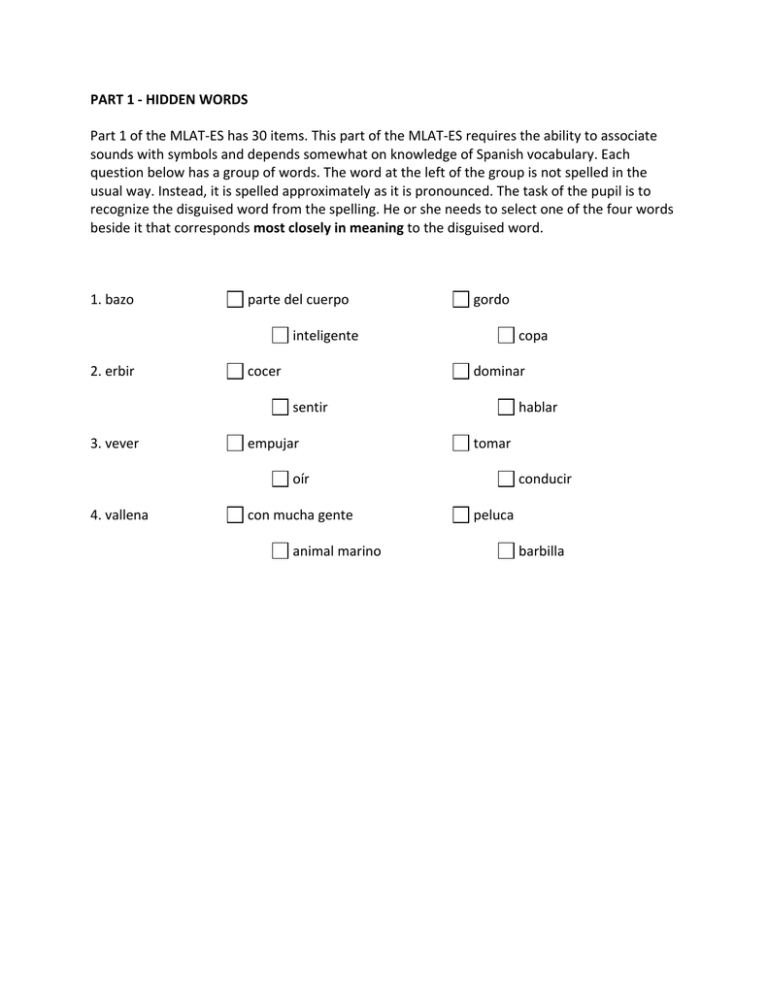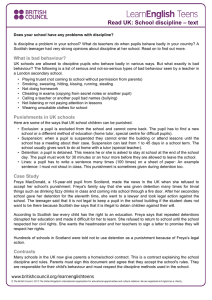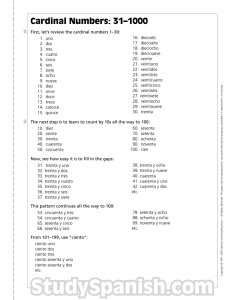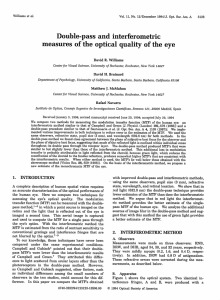PART 1 - HIDDEN WORDS Part 1 of the MLAT
Anuncio

PART 1 ‐ HIDDEN WORDS Part 1 of the MLAT‐ES has 30 items. This part of the MLAT‐ES requires the ability to associate sounds with symbols and depends somewhat on knowledge of Spanish vocabulary. Each question below has a group of words. The word at the left of the group is not spelled in the usual way. Instead, it is spelled approximately as it is pronounced. The task of the pupil is to recognize the disguised word from the spelling. He or she needs to select one of the four words beside it that corresponds most closely in meaning to the disguised word. 1. bazo 2. erbir parte del cuerpo inteligente cocer empujar oír con mucha gente sentir 3. vever 4. vallena animal marino gordo copa dominar hablar tomar conducir peluca barbilla PART 1 ‐ HIDDEN WORDS Correct Answers: 1. bazo is a disguised spelling of vaso (drinking glass), which corresponds in meaning to copa (drinking cup) 2. erbir is a disguised spelling of hervir (to boil), which corresponds in meaning to cocer (to cook) 3. vever is a disguised spelling of beber (to drink), which corresponds in meaning to tomar (to drink) 4. vallena is a disguised version of ballena (whale), which is an animal marino (marine animal) PART 2 ‐ MATCHING WORDS There are 30 questions in MLAT‐ES Part 2. The questions test recognition, analogy, and understanding of a far greater range of syntactic structures than the 4 sample questions shown here. Although knowledge of grammatical relationships is measured in this part, no explicit reference is made to grammatical terminology, so grammatical sensitivity is measured without measuring grammatical knowledge gained through formal instruction. In each of the following questions, we call the first sentence the key sentence. One word in the key sentence will be underlined and printed in capital letters. The task is to select the word in the second sentence that plays the same role in that sentence as the underlined word in the key sentence. 1. Ayer, María rompió el VIDRIO. Carolina cortó la torta con un cuchillo. 2. Beatriz CANTÓ una canción bonita a su clase. Óscar tira piedras grandes al lago. 3. Pedro recibió un gato BLANCO por su cumpleaños. Mi hermana comió una manzana grande el miércoles. 4. El PERRO peludo ladraba toda la noche. ¿Fue a la tienda Paco para comprar pan? PART 2 ‐ MATCHING WORDS Correct Answers: 1. A mark would be put in the box beneath torta. In the first sentence, something was broken, and the thing that was broken was a VIDRIO (window). In the second sentence, something was cut, and that thing was a torta (cake). 2. A mark would be put in the box beneath tira because CANTÓ (sang) in the first sentence and tira (throws) in the second sentence are both the action that occurs. 3. A mark would be put in the box beneath grande because BLANCO (white) in the first sentence describes the cat and grande (big) in the second sentence describes an apple. 4. A mark would be placed in the box beneath Paco because the first sentence is about a PERRO (dog) and the second sentence is about Paco. PART 3 ‐ FINDING RHYMES There are 40 items in Part 3 of the MLAT‐ES. This portion of the test measures the pupil’s ability to hear and make distinctions between speech sounds. Some knowledge of Spanish vocabulary is required for this part. In each of the questions below, the word in CAPS is called the stimulus. The pupils are asked to mark the box next to the word that best rhymes with the stimulus. 1. YESO paso piso tropiezo ocio 2. AMIGO obligó ombligo refugio hormiga 3. TESORO oro tijera taro sordo 4. BUENO tengo muerdo heno pino PART 3 ‐ FINDING RHYMES Correct Answers: 1. tropiezo 2. ombligo 3. oro 4. heno PART 4 ‐ NUMBER LEARNING Part 4 of the MLAT‐ES has 25 possible points. This part of the MLAT‐ES tests auditory and memory abilities associated with sound‐meaning relationships. In this part of the MLAT‐ES, the pupil will learn the names of numbers in a new language. Subsequently, he or she will hear the names of numbers spoken aloud, and will be asked to write down these numbers. For example, if you heard someone say the number “seventeen” in English, you would write down 1 7. But in this test, the pupil will hear the numbers in a new language. Here is how it will work: The pupil will hear some instructions read aloud. The speaker will then teach him or her some numbers. The speaker will say something like: [The red text represents the voice heard by the pupil.] En esta parte de la prueba vamos a aprender los nombres de algunos números en un idioma distinto. Yo voy a decir el nombre de cada número. Ahora, a escuchar con mucha atención. “ba” es “uno” “baba” es “dos” “dee” es “tres” Ahora, yo voy a decir el nombre de unos números, y hay que escribir los números correspondientes. “ba” “Uno” es la respuesta correcta. “dee” “Tres” es la respuesta correcta. “baba” “Dos” es la respuesta correcta. Ahora, vamos a aprender los números para “veinte” y “treinta”. “tu” es “veinte” “ti” es “treinta” “tu‐ba” es “veintiuno” en este idioma porque “tu” es veinte y “ba” es uno. “ti‐ba” es “treinta y uno“ porque “ti” es treinta y “ba” es uno. Aquí vamos a hacer lo mismo que hicimos en los ejercicios de práctica: apenas yo diga las palabras hay que escribir el número correspondiente. Vamos a empezar. a. ti‐ba [the pupil has only about 5 seconds to write down each answer] b. ti‐dee c. baba d. tu‐dee PART 4 ‐ NUMBER LEARNING Correct Answers: a. 31 b. 33 c. 2 d. 23





